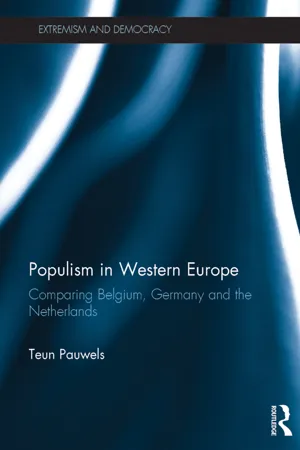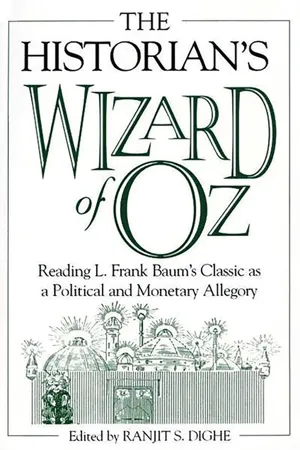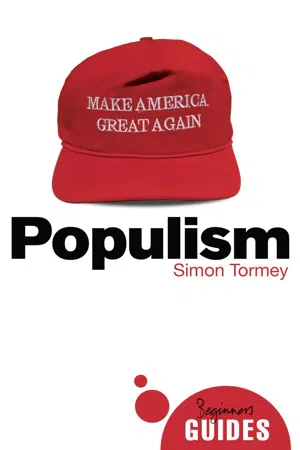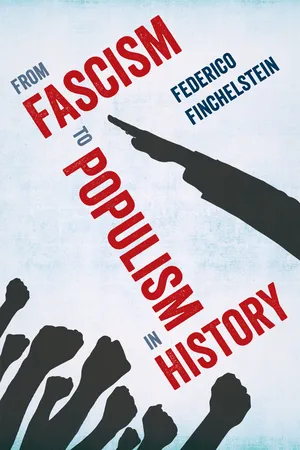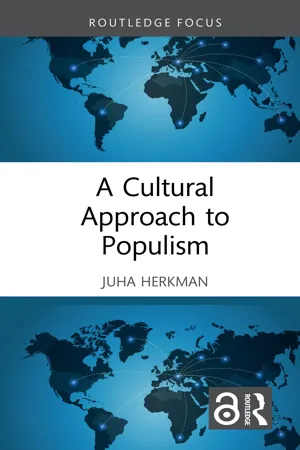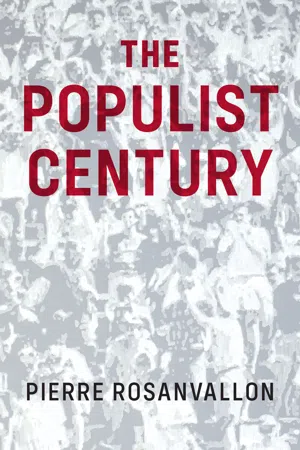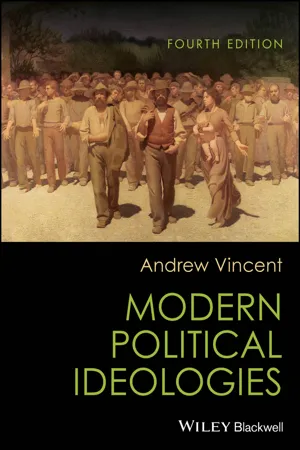History
American Populism
American Populism refers to a political movement that emerged in the late 19th century, advocating for the interests of the common people against the elite. It emphasized economic reforms, such as the free coinage of silver and regulation of monopolies, and sought to empower farmers and workers. American Populism had a significant impact on the political landscape and influenced later progressive and reform movements.
Written by Perlego with AI-assistance
Related key terms
10 Key excerpts on "American Populism"
- eBook - ePub
- Teun Pauwels(Author)
- 2014(Publication Date)
- Routledge(Publisher)
One solution to this problem is to list the most important phenomena that have been labelled by scholars as populist and to search for a common denominator (Mudde, 2007: ch 1; Rooduijn, 2013: ch 2). This is why the different waves of populism will be briefly explored in the next section. By analysing populism in a broader perspective – across space and time – the pitfall of arriving at a contextual definition is minimized. Most scholars agree that we can distinguish between three waves of populism (Taggart, 2000). The first dates back to the second half of the nineteenth century when the Russian Narodniki and US People’s Party gained momentum. The second wave refers to Latin American Populism in the twentieth century, most notably in the form of Peronism. Finally, a third wave of populism emerged in the late twentieth century when parties such as the Front National (National Front, FN) in France and the Belgian VB established themselves in the party systems of European democracies.The American People’s Party and the Russian Narodniki‘The case of populism in the nineteenth-century USA is often seen as the example of populism’(Taggart, 2000: 29). Its roots lie in the legacy of the Civil War (1861– 1865) between the North and the South of the country. After the Civil War, the defeated South largely remained an agrarian society depending mainly on cotton for economic welfare while the urban North contained the most important political and financial centres of power. Confronted with an international economic depression, farmers and mineworkers joined forces in the so-called People’s Party to fight the dominance of a small but powerful class of bankers and industrials. ‘The rise of the Populist movement and the People’s Party represented the mobilization of a particular regionally-based defence of agrarian radicalism against the economic and political power of the North and against the failure of the party system to represent this new force’ (Taggart, 2000: 31).Farmers were considered to be productive and dutiful citizens and were contrasted with the conniving elite. The People’s Party was sceptical towards the political system and demanded repertoires of direct democracy. It is important to note that the populist surge in the US was an example of upward mass mobilization and not the consequence of charismatic leadership. Eventually, the People’s Party got involved in party politics and achieved some successes between 1888 and 1894, but it did not succeed in challenging the dominant positions of the Republicans and Democrats. After a period of internal conflicts combined with economic recovery, the movement fell apart and became largely integrated into other political movements (Jagers, 2006: 25). Notwithstanding the fast disintegration of the People’s Party, populism has remained deeply rooted in the US society (Kazin, 1995). From time to time, this populism emerges, for instance with the campaign of Ross Perot as an independent candidate for the 1992 presidential elections or with the more recently established Tea Party and Occupy Wall Street movements. - eBook - ePub
The Historian's Wizard of Oz
Reading L. Frank Baum's Classic as a Political and Monetary Allegory
- Ranjit S. Dighe(Author)
- 2002(Publication Date)
- Praeger(Publisher)
Chapter 3“Populism Will Put Them to Sleep” : A Short History of the Populist Movement of the 1890sPopulism is sure to retain its fascination for students of history as long as people remain sensitive to questions of democracy and human rights in a world increasingly driven by the consequences of an ongoing technological-corporate revolution.—Gene Clanton 1INTRODUCTION
The word populism appears frequently in political discourse. In the 2000 presidential campaign, for example, pundits commented endlessly on the “populist” tone of A1 Gore’s acceptance speech at the Democratic Convention, in which he promised to fight for ordinary Americans against “the powerful interests.” A New York Times editorial noted “Warring Populisms” on the part of the two major parties: Democrats tend to stress an economic populism, in which they claim to be the defenders of working-class Americans against the excesses of big business, while Republicans tend to stress a cultural populism, in which they claim to be the defenders of traditional values against intellectual elites, and an economic populism of their own, aimed at big government and “tax-and-spend liberals.”Populist appeals of those kinds date back a long way in American politics, at least as far back as the “Jacksonian Democracy” of the 1820s and the early days of the Republican Party as the party of “Free Soil, Free Labor, and Free Men” in the 1850s. Such appeals to “the common man” reached their fullest expression in the turbulent decade of the 1890s, with the formation of a third party that grew out of farmers’ protest movements and sought to ally itself with blue-collar workers and opponents of monopolies. The term Populist was coined in 1891 to denote members of the incipient party, which was officially known as the People’s Party.2 - eBook - ePub
Rebellion in America
Citizen Uprisings, the News Media, and the Politics of Plutocracy
- Anthony DiMaggio(Author)
- 2020(Publication Date)
- Routledge(Publisher)
I also analyze populism relating to intersectionality. For Sanders’ campaign, public support was significant among poor whites, while he struggled to reach poor people of color. Trump’s populism appealed to more affluent groups, including middle-to-higher-income whites. For white male Trump supporters, suspicion of immigrants drove opposition to welfare spending for the poor. Trump’s populism demonstrates plutocratic politics is alive and well, with tens of millions being mobilized on the right to fight a re-emerging culture war. Business interests benefit from government policies enhancing the power of the wealthy. The rise of plutocracy, however, is not unchallenged. The prominence of Sanders’ 2016 and 2020 campaigns – particularly among younger Americans disillusioned with the political-economic status quo – suggests populist forces matter to Democratic Party politics.Populism: A Background
Social scientists are not all of one mind on populism. But there are traits upon which many agree. One is the claim that individuals in rebellion are malcontents who oppose what they see as a corrupt status quo. Kazin argues that the American populist movement of the late nineteenth and early twentieth centuries built “a grand coalition of outsiders” against plutocratic politics, coalescing around the Populist Party. This alliance included southern, Midwestern, and western farmers, who joined with urban laborers, to combat industrial monopolies and financial elites.3 The hope was “the David of populism would be able to convince enough Americans to join in toppling the Goliath of concentrated wealth and corrupt state power.”4 Populists offered “a collection of demands” for progressive taxation, coinage based on silver and gold standards, nationalization of the railroads, prohibition, and anti-trust reforms to break up monopolies of the “Gilded Age.”5Efforts to transcend historical periods and movements have produced some agreement on defining populism. It includes efforts to separate masses of people on one side, and those controlling political, economic, and social institutions on the other.6 Mudde and Kaltwasser discuss populism via portrayals of “the people” as “pure” in comparison to “elites” who are self-serving and “corrupt.”7 But defining “the people” in an unbiased way is impossible, since right- and left-wing populists construct definitions of “worthy” and “unworthy” based on ideology.8 - eBook - ePub
- Simon Tormey(Author)
- 2019(Publication Date)
- Oneworld Publications(Publisher)
2
What is populism? (and why does it seem so difficult to define?)
Populism seems to be very much on the rise. Indeed, as far as some commentators are concerned, populism ‘exploded’ in 2016, sparking the fear that we are entering new and uncharted political waters, an era of populist ‘contagion’ no less.This presumes that we know what populism is. But do we? There seems to be little consensus as far as the academic literature is concerned. Margaret Canovan argues in her classic study that populism is a kind of political movement or ideology that places the idea of a unified people at the core of its vision. Cas Mudde influentially adjusted that view to argue that populism is not really a fully-fledged ideology, like socialism or liberalism, but a ‘weak’ ideology that augments other ideologies, such as authoritarianism or nationalism. Jan-Werner Müller identifies populism with an ‘inner logic’ that drives out pluralism and presages the onset of an intolerant regime injurious to liberal democracy. Ben Moffitt describes populism as more of a performative style, a politics associated with ‘bad manners’ and a brusque confrontational approach at odds with mainstream democratic approaches. By contrast Ernesto Laclau and Chantal Mouffe assert that since populism equates to a discourse of the people, it is fundamental to a properly democratic politics. Finally, media commentators such as Robert Peston and Steve Richards see populism as simply a proxy for ‘outsider’ forms of politics that challenge the elites.Populism lends itself to a wide variety of definitions and uses. At one level there’s nothing very unusual in political concepts being used in different ways in different contexts and for meanings to be contested. Indeed, there are concepts that are so debated that we have come to see them as ‘essentially contested’. These are concepts such as liberty and equality, where how we define the concept reflects our own ethical and political commitments. As long as there is disagreement about how we should organise ourselves, there will be disagreement about how we frame and define the key concepts we use to describe the world as it is and as it ought - eBook - ePub
- Federico Finchelstein(Author)
- 2019(Publication Date)
- University of California Press(Publisher)
95 But in populism, all these traditions became connected. In this context, populism conflated political representation with full delegation and linked both with a mythical idea of the past, when democracy really worked. Thus, populism presented itself as a return to the past but also as a future when tolerance and diversity would cease to have a prominent political role. More than in other places, American Populism has always been able to go back to its democratic origins, but as everywhere else these origins often were watered down, restricted to the majority, and mythically conceived as a source of redemption from plurality.As was the case for the rest of the world, the end of the Second World War significantly transformed the United States. The postwar economic order and the new hegemonic status of liberalism minimized the populist potential of the left, allowing the populism of the right to be the predominant strain north of the Panama Canal. Nonetheless, for the rest of the century populism was co-opted, and restrained, by more conservative elements inside and outside of the Republican Party. This situation increasingly changed, especially after the related cycles of neoliberalism, technocracy, and economic crisis of our new century. Finally, in 2017, American extreme-right populism reached power.At the level of a movement, the Tea Party, and later Trumpism in the United States presented similar authoritarian interactions to those who have historically defined populism across the globe. The logic of populist radicalization exalted the opposition between the people and the Other—namely, the imagined enemies of the people. This extreme antagonism was precisely what many followers wanted from their leaders. As Pablo Piccato and I argued in 2016 with respect to Trumpism, “Some observers believe—or, perhaps, hope—that Trump’s followers misunderstand or don’t believe in what he represents. They’re wrong.” These observers included President Barack Obama, who suggested that Trump’s followers were misguided. However, several studies observed a correlation between resentment against African Americans and immigrants and support for Trump. We argue that “His supporters like Trump not despite his anti-democratic qualities, but precisely because of them.”96 - eBook - ePub
- Francisco Panizza, Francisco Panizza(Authors)
- 2020(Publication Date)
- Verso(Publisher)
7 To talk of a marriage does not settle the question either, for despite the general advocacy of market liberalisation, the differences in the policies they follow once in office remain far too large to allow us to identify this as a common denominator that could function as the genus of the more recent incarnations of the populist experience.To complicate matters further, the populist drive seems to be virtually indistinguishable from the ‘politics of faith’ – as Oakeshott calls it – that has characterised a wide range of reform movements throughout modernity.8 For example, the will to renew politics, the exaltation of the people, and the presumed immediacy of their link with the leader or the party are present in political movements that are not usually branded populist. Besides, one cannot fail to notice that the terms we have been using – populism, modern politics, democracy and reform – do not cease to overdetermine or contaminate one another, and as a result, the conceptual frontiers between them become rather unstable. This puts a limit to any pretension to disambiguate fully the ‘as such’ of populism vis-à-vis politics. The conceptual contours of the term remain fuzzy, and its theoretically contested status unabated, to the extent that we might want to describe populism as an ‘anexact’ object. I take this paradoxical expression from Deleuze and Guattari, who in turn borrow it from Husserl’s writings on protogeometry or science that studies vagabond or nomadic morphological essences. ‘Protogeometry’, they say, ‘is neither inexact like sensible things nor exact like ideal essences, but anexact yet rigorous (“essentially and not accidentally inexact”). The circle is an organic, ideal, fixed essence, but roundness is a vague and fluent essence, distinct both from the circle and things that are round (a vase, a wheel, the sun) … At the limit, all that counts is the constantly shifting borderline’.9 - eBook - ePub
- Juha Herkman(Author)
- 2022(Publication Date)
- Routledge(Publisher)
The ideas above largely echo Ernesto Laclau’s and Chantal Mouffe’s theorisations. However, the problem with Laclau and Mouffe’s populism theory is that it is essentially a theory of all kinds of political awakening, the emergence of political movements and the starting points of political activity, whereas populism has mainly described a certain type of limited political activity. Populism does not have to be understood only negatively or used as a political brawl, but as a concept it loses its ability to be analytical if it refers too broadly to the construction of political self-understanding and identification through the use of antagonisms. According to its etymology, the essence of populism is the perception of common, indivisible people whose will is ignored in politics. Populism is not about pushing the interests of workers or unemployed people, such as in left-wing ideology, or promoting the interests of the middle class or upper class, such as in right-wing ideology. Moreover, it is not about the environmental awareness of a liberal population, such as the green movement, or the defence of conservative Christian, Islamic or Hindu values in the same sense as political movements based on religion. Populism is separated from other politically constructed antagonisms by politicising the idea of “the will of the people” by combining different, even contradictory, interests and ideologies under the same nominator of the people.As such, populism can be defined as follows:Populism is an affective process of political identification, which builds antagonism between two imaginary factions, a misunderstood people and the groups that threaten its sovereignty (elites, immigrants, or other minorities). Populist identification uses ideologically and morally loaded signifiers that are suited to context-laden political demands.This definition of populism can be called a cultural approach to populism with an emphasis on the rhetorical, performative and discursive dimensions of the populist process combined with a politological perspective on the structures and contexts related to the emergence and practices of populism. It therefore builds a bridge over the gap between ideational and Laclaudian traditions in populism studies that enables a deep theoretical understanding of contemporary populism but also empirical research on the populist called phenomena and movements in party politics, media and democracy. The core of this cultural approach to populism is in the ways populism combines cultural processes of significations – giving politicised meanings to things – and affective identifications – creating social belonging and exclusion – in political identities. - eBook - ePub
The Populist Century
History, Theory, Critique
- Pierre Rosanvallon, Catherine Porter(Authors)
- 2021(Publication Date)
- Polity(Publisher)
26 To be sure, this culture was manifested in very different ways from country to country; France was the most strongly marked, the United States to a lesser degree. No populist regime actually saw the light of day, however, and no movement of that nature came even close to winning power. Why so? It is essential to address these questions if we are to identify what distinguishes our contemporary populist moment from the previous ones. The answers, like the manifestations themselves, vary by country.In the United States, virulent criticism of the political parties was initially characterized by what it failed to address: the overall constitutional architecture of the country was not called into question. The critique was channeled, in a way, by the adoption of some of the essential propositions of the Progressive Movement. Thus, at the turn of the century, in more than a third of the states, primarily in the West and Midwest, procedures for referendums and popular initiatives were put in place, along with procedures for recalling elected officials at various administrative levels (ranging from judges and sheriffs to governors).27 The system of electoral primaries was adopted at the same time by a large number of states.28 These measures largely eradicated the political roots of populism in the United States, even if, at a more general level, “Washington” remained stigmatized as the source of everything that was wrong in the country. The political culture of mistrust was effectively contained by being reoriented. In the face of the rising potency of a national protectionism tinged with xenophobia, the American response was even harsher. In addition to restrictive immigration policies, the demand for protection rebounded toward a consolidation of the racial boundaries between Blacks and Whites. For many, protection of whiteness became the priority, as attested by the segregationist policies established in the Southern states during this period. American Populism thus found an outlet in racism.In Germany and in England, populist accents were less pronounced. Protectionist ideas, strongly associated with a higher cost of living, did not penetrate very deeply in England, despite the energetic campaign in their favor led by Joseph Chamberlain.29 The Labour Party argued vigorously against the protectionist mantra, and it did not stop at vaunting the benefits of an open economy. Real protection, as party leader Ramsay Macdonald insisted, lay in labor laws and public control of economic activity.30 For their part, left-wing British economists (those known as the “new liberals,” along with followers of John Maynard Keynes) challenged the imperialist vision that went along with the protectionist tendency in England. They argued for redistribution of income and for social reforms while denouncing the illusion of imperial protectionism.31 In Germany, industrial successes based on exports meant that the world of labor remained relatively impervious to protectionist appeals.32 - eBook - ePub
- Joost Jongerden, Joost Jongerden(Authors)
- 2021(Publication Date)
- Routledge(Publisher)
7Populism in Turkey
From a political style to a model for global politics?
M. Asım KaraömerlioğluIntroduction
As a concept, populism has been used to interpret political movements for more than a century. Some examples of the populist experiences include the People’s Party of the 1890s in the US, the Russian Narodnik movement in the 1870s, agrarian upheavals in many Balkan countries in the aftermath of World War I, the Turkish state-sponsored Halkçılık of the 1930s, the Peronist regime in Argentina and several similar examples in Latin America in the aftermath of World War II. Given the extraordinary diversity these movements exhibit in time and space, it is not surprising that populism has also been one of the most controversial concepts of political science (Stewart 1969 , 180). As a matter of fact, scholars so far have not had any consensus as to the nature of populism, although it is true that in terms of style , populist regimes display some common characteristics. They have generally shared an understanding of political life based on a duality between people and elites, emphasized a direct and organic link between the ruled and the leader, were against liberal notions of democracy, used overwhelmingly nativist and nationalist discourses and opposed political analyses based on social classes. Despite all these common points, however, populist regimes and movements in the past were all products of different historical and social dynamics. Moreover, many other political regimes have similar characteristics, practises and discourses with populism.Yet, from around 2010 onwards, a new version of populism, perhaps better labelled as neopopulism, now emerging simultaneously and sharing extraordinary common characteristics, became the hegemonic political Zeitgeist of our time, especially after Donald Trump and Brexit in 2016. This neopopulism, despite displaying national peculiarities, has many commonalities in terms of style, approach, visions and political aims. They all use binary oppositions such as the people versus elites, criticize the liberal world order, condemn globalism, adhere to the notion of a majoritarian view of democracy, abuse democracy by reducing it simply to electoral success, despise the system of checks and balances in politics, advocate an anti-establishment discourse and resort to a “post-truth” discourse. Interestingly, the Turkish political regime that Recep T. Erdoğan consolidated in the 2010s is one of the earliest and most sophisticated versions of this recent neopopulist upsurge. - eBook - ePub
- Andrew Vincent(Author)
- 2023(Publication Date)
- Wiley-Blackwell(Publisher)
2000 , 55).Nonetheless there are some conceivable populist intersections with socialism (see Olsen 2017 ). As in the other ideologies discussed, this is largely because populism can easily access and utilize many socialist ideas. Some have also argued that it is important that radical right populism should be critically challenged by a left‐wing alternative (see Mouffe 2018 ). As indicated earlier, populism has no specific economic agenda and is fluid enough to adapt to any economic policy, with the sole exception of globalized neoliberalism. Socialism, even within market socialism, liberal socialism or social democracy, tends to want to regulate capitalist markets and, in some cases, such as Marxism, to abandon capitalism altogether. This stance can be adopted by socialist‐inclined populism. Yet, this economic stance is certainly not characteristic of many populist variants to date. Further, most forms of socialism are undoubtedly committed to the overall welfare of the people, in many cases advocating for both equality and social justice. However, there remains ambiguities as to who the people are here within the socialist frame.The concept people within Marxist‐Leninism, for example, is usually focused upon a social class. Thus, if one were to speak of the agrarian peasantry, the bourgeoisie, capitalist proprietors, the lumpenproletariat and so forth, these tend to be noticeably separated out from the authentic people, that is, the industrial proletariat. In fact class struggle is anticipated in such a scenario. Within social democratic thought and revisionist socialism the people become a more open category, usually settling upon citizenship, although class still haunts the arguments to the present day. These intricate ongoing arguments over the nature of the people within socialism are largely absent from recent examples of socialist populism. Finally, the bulk of social democracy and socialist revisionism during the twentieth century have been largely acclimatized to liberal democracy and Parliamentary party systems. This further entailed an acceptance of the liberal state and its institutional levers of power. Yet populism, in general, has remained deeply uneasy with liberal democracy, existing party systems and any elite establishment. In these senses, socialism seems to be the least accommodating host for populism in comparison with both radical right and nationalist ideologies.
Index pages curate the most relevant extracts from our library of academic textbooks. They’ve been created using an in-house natural language model (NLM), each adding context and meaning to key research topics.
